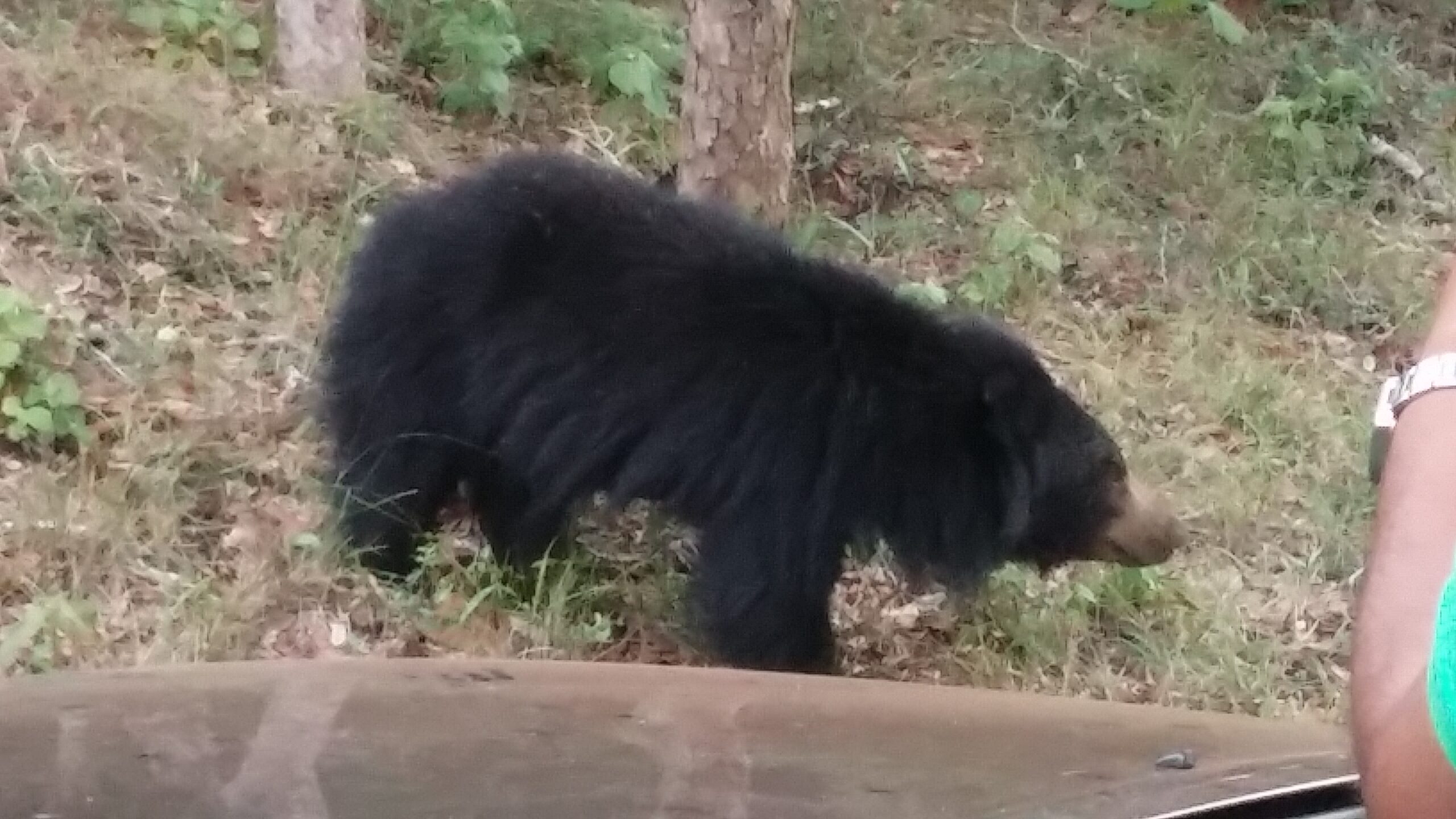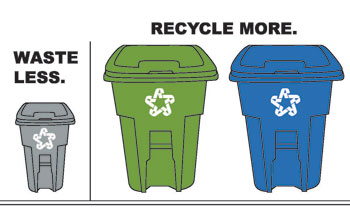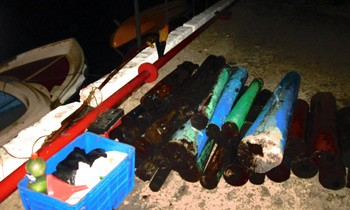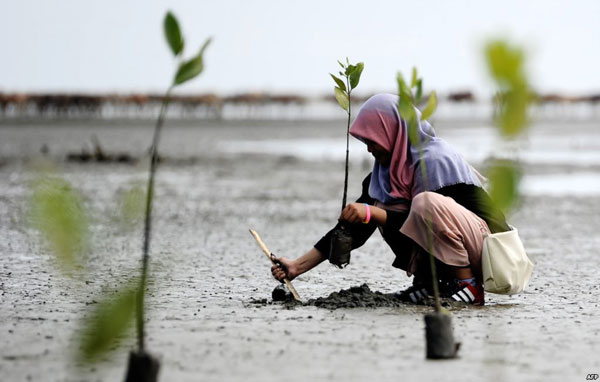
BSL in association with CIC Holdings and BEAR for ESTIMATING THE SLOTH BEAR POPULATION IN WILPATTU NATIONAL PARK
 The Sri Lanka Sloth Bear (Melursus ursinus inornatus) is a subspecies which is endemic to the island nation. The sloth bear is one of the most adversely affected animals due to deforestation and urbanization. As, this species is very sensitive to disturbances, currently it is restricted to the National parks and sanctuaries in the lowlands of the island. Due to prevalent misconceptions among the villagers, the sloth bear has earned the reputation as one of the most dangerous animals in Sri Lanka. It is deliberately avoided by jungle men as the most feared creature in Sri Lanka’s wilds. Even to date, the sloth bears are killed by villagers whenever an opportunity arises, during their forages to the forest to collect honey and other forest products. During the survey several dead sloth bears were found close to villagers, their death was due to gun shots and snares. Sloth bears were reported as abundant during the colonial period, but declined speedily and drastically due to habitat loss and hunting. The colonial sports men used to sit over water holes during the dry season to shoot sloth bears, which come to quench their thirst – sloth bears unlike other large mammals need to have their daily fill of water.
The Sri Lanka Sloth Bear (Melursus ursinus inornatus) is a subspecies which is endemic to the island nation. The sloth bear is one of the most adversely affected animals due to deforestation and urbanization. As, this species is very sensitive to disturbances, currently it is restricted to the National parks and sanctuaries in the lowlands of the island. Due to prevalent misconceptions among the villagers, the sloth bear has earned the reputation as one of the most dangerous animals in Sri Lanka. It is deliberately avoided by jungle men as the most feared creature in Sri Lanka’s wilds. Even to date, the sloth bears are killed by villagers whenever an opportunity arises, during their forages to the forest to collect honey and other forest products. During the survey several dead sloth bears were found close to villagers, their death was due to gun shots and snares. Sloth bears were reported as abundant during the colonial period, but declined speedily and drastically due to habitat loss and hunting. The colonial sports men used to sit over water holes during the dry season to shoot sloth bears, which come to quench their thirst – sloth bears unlike other large mammals need to have their daily fill of water.
In Sri Lanka, population estimates and abundance of the sloth bear is greatly lacking. In order to fill this gap in knowledge and to gather base line data on their population density and home range, the current project was initiated, first in Wilpattu National Park, as it is reported to harbour one of the largest populations of sloth bear, as per a study done in the 1970’s by Eisenberg and Lockhart. This forms the first stage in an island wide study on the Sloth Bear in Sri Lanka.
Our goal is to map, evaluate the population density and composition of sloth bears in Wilpattu National Park and to identify their habitat needs and preferences. The information gained through this study can then be applied island wide in the subsequent strategies and efforts for the conservation of the sloth bear.
The project was initiated on the 3rd of June 2013 with the financial support from CIC Holdings PLC through Biodiversity Sri Lanka. To date over 100 field days have been spent in the wilds of Wilpattu for the said survey and study.

Environmentalists fire warning shots over “senseless” jumbo killing
The elephant being rescued, but soon the she elephant lay dead. Pix by Ramesh Madushanka
A wild elephant is dead – at the hands of the Department of Wildlife Conservation (DWC), the very institution which is supposedly the guardian of these majestic animals.
“When will we ever learn,” is the lament of numerous environmentalists as there were howls of protest not only from them but also the public over this “senseless” killing.
The DWC over-reacted and used excessive force than was necessary, was the consensus among them, as two parallel probes were launched by Wildlife and Sustainable Development Minister Gamini Jayawickrama Perera and the DWC.
The video of the shooting of the cow-elephant in Kombaveittakulam, Omanthai, Vavuniya is heart-rending. Two adult females and their babies had fallen into an agricultural well. Perhaps, a baby fell in first and in their efforts to save it the others fell in too. The two babies were apparently taken out first by the DWC. The agony and the stress of the two bigger elephants, left swimming round and round, attempting to get out of this watery trap is obvious.
Then comes into view, in the eyes of the elephants, what would have been a different threat – a huge orange backhoe, while in the background the so-called rescue personnel including the DWC staff can be heard shouting at the animals. A ‘circus’ seems to ensue thereafter.
In the last moments of her life, the desperation of the cow-elephant, firstly struggling to get up the muddy and slippery slope of the well can actually be felt even through the video. Her futile attempts to charge at the orange monster blocking her escape route into the jungle and finally, the sound of one shot, a cloud of smoke, a second shot and another cloud of smoke and a third shot and a cloud of smoke and as if in slow motion, the majestic elephant collapses and drops dead. Since it is believed that she was a nursing mother, her killing also condemns her baby to death by starvation.
Whether the other elephant was also injured, as a gun-shot seems to be in that animal’s direction as well, remains a mystery.
DWC sources told the Sunday Times that the department was conducting an inquiry and the report was expected early next. When asked for details with regard to the incident, the source said that the well was about 12km off the A9, in a rural area. The rescue operation was carried out at around 9.30 a.m. on Monday (April 17). The elephants had been spotted in the well the previous day. There were two cow elephants and two babies, but the DWC was not certain whether the babies were of those cow elephants.

“There was absolutely no need to shoot dead the elephant which was of little threat to the DWC guard who was on the backhoe,” was the view of experts who analyzed this particular incident and pegged it to a wider issue.
“Elephants charging at vehicles happens not uncommonly and jeeps do get hit in wildlife parks. Raiding elephants often attack tree huts in chenas and elephants break down houses to get at stored grain. Killing an elephant is not considered the appropriate response in any of these instances,” said the Chairman of the Centre for Conservation and Research (CCR), Dr. Prithiviraj Fernando, who has been conducting research on elephants for nearly three decades.
Reiterating that many other measures could have been tried, before shooting dead the elephant, he said that the most logical first reaction should have been — when they saw the animal coming out — was to move the backhoe, which was clearly blocking her pathway to freedom. There seems to have been no thinking or planning before using fire-power to kill.
Even if the backhoe was not moved, the animal could have been diverted from heading towards the backhoe by fire-crackers first and if those did not work, then non-lethal bird-shot from a shot-gun. These are tiny lead pellets which would hit the skin of the elephant and caused pain but not go through and leave huge fatal injuries. The cartridges with large lead balls used in this instance as a first resort were absolutely the wrong ammunition. The DWC guard could have also shot at the body and not made a direct hit at the head of the elephant, the Sunday Times understands.
While the ‘lighter’ measures such as fire-crackers and bird-shot are tried out, another official could stand-by with a rifle to take down the animal if human life is endangered. But killing the elephant should be the very last resort, according to Dr. Fernando. “It should definitely not be the first-line of defence.”
The Wildlife and Nature Protection Society (WNPS), meanwhile, in a statement issued on Thursday night, titled ‘From protector to executioner’ strongly protested against the shooting.
As the oldest conservation organization of its kind, the founder of the initial National Parks and prime facilitator in the setting up of the DWC, the WNPS underscored that this act of needless destruction of a nationally-protected species by those who should be protecting them counters every principle of conservation on which these institutions were established.
“The available video coverage of the incident clearly shows that at no time was human life in danger during the incident and the need to shoot the elephant dead, rather than just frighten it away as has been done before, is called into question. The video also shows another elephant being shot at and falling, though the DWC claims that only one died. The DWC is the main statutory agency set up for the protection of all wildlife, including elephants. If they have now taken to shooting the animals they are supposed to protect, then an already endangered species is doomed to extinction,” it said.
Strongly urging that the two inquiries into this elephant-killing be carried out with a degree of transparency that leaves nothing open for question, the WNPS states that as per the available video footage of the incident, the ‘circus’ that surrounded this tragic killing, highlights alarming lapses in procedure and gaps in the law. They include:
Astoundingly, the DWC does not have an official protocol or procedure to deal with situations like this, the extrication of wild elephants from unguarded irrigation pits/wells, despite it being an all too frequent occurrence of late. Had they done so, the army of onlookers would have been cleared and appropriate measures taken to channel the rescued animals away from the rescuers.
If a human falls into an unguarded well or pit, the person or persons who made the excavation are legally liable for any resulting injury and costs. Yet, when an elephant falls into such a hole, the DWC is not only held liable for its extraction, but has to bear the resulting costs. These wells/channels are often paid for by aid agencies and they should ensure that basic measures are taken not only to prevent elephants and other animals from falling in, but also humans. Those who dig these holes and leave them unguarded should be held liable to pay for the costs of anyone or any animal falling in. Such legal measures, if enforced, would soon result in proper safety measures being implemented for the wellbeing of all – humans and animals.
“It is hoped that this tragedy will result in the DWC and the ministry commencing discussions and consulting elephant and legal experts to formulate a protocol to deal with such situations where the destruction of the animal will be the last resort, rather than the first, trigger-happy choice. It is too late for this unfortunate victim but the world will be watching to see whether justice will prevail in her killing and whether there is any hope for the conservation of the wild elephant under the present political and administrative institutions responsible for their protection and under the law,” the WNPS adds.
Another environmentalist also pointed out that the DWC guard, who shot dead the elephant, has been transferred to a different area, which indicates that the DWC has not acknowledged the fundamental reasoning that the killing was not acceptable. What the right course of action would have been is to send the official on compulsory leave, as the killing of an elephant is against the law of the country, at least until the investigations were concluded. The message from the current actions is that it is acceptable to kill an elephant even though it is an illegal act under Sri Lankan law.
Taking up a press release issued by the Game-guard Union that the guard’s action was justified because the elephant was “on a rampage and the killing was carried out in self-defence”, another environmentalist was quick to point out that the video clearly shows that the ‘rampage’ part was totally untrue.
The implication of such a stance is very dangerous, he said, adding that it promotes the thinking that elephants should be killed and that’s what villagers will do, making the human-elephant conflict take on a different dimension. “We will give villagers an excuse to take the law into their own hands if an elephant damages a home or a tree-hut. The message being told loud and clear, wrongly, is that when faced with an aggressive elephant you should kill it.”
Source – 23/04/2017, The Sunday Times, See more at – http://www.sundaytimes.lk/170423/news/environmentalists-fire-warning-shots-over-senseless-jumbo-killing-238070.html

Legislation to enforce garbage recycling
The Government will, within two months, introduce legislation to enforce the recycling of garbage, informed sources said yesterday. They said the Prime Minister was monitoring the progress of the new Bill, which is now under preparation.
“Sri Lanka is one of the few countries in Asia that does not have specific laws pertaining to recycling of garbage and therefore the government has decided to introduce laws pertaining to this issue,” a source said adding that this matter was being expedited in the aftermath of the Meethotamulla tragedy which killed more than 30 people. (Yohan Perera) .
Source – 23/04/2017, Daily mirror See more at: http://www.dailymirror.lk/article/Legislation-to-enforce-garbage-recycling-127585.html#sthash.ZLeuud9h.dpuf

One arrested with 511 kgs of red sandalwood
An individual, who attempted to smuggle 511 kgs of red sandalwood into the country from India via sea, was arrested by the Navy today. The suspect was arrested on receipt of intelligence information to the Navy.
The Navy said the search operation was carried out in the Anawasala area in Kalpitiya and the racketeer was nabbed along with the dinghy used for the transportation of the high – valued red sandalwood stock. The suspect and the stock of red sandalwood were handed over to the Sri Lanka Customs Sub-Preventive Office in Sinnapadu for legal action.
Source – 23/04/2017, Dailymirror, See more at: http://www.dailymirror.lk/article/One-arrested-with-kgs-of-red-sandalwood-127602.html#sthash.kpJfD9xV.dpuf

Earth Day observed around the world
Earth Day was observed around the world yesterday with tree plantings, exhibits, cleanups and protests. Members of an ecologist group known as ”Comando Borraja” (Borage Commando) plant some vegetables and flowers in a street of Tudela village, northern Spain, in commemoration of Earth Day, April 22, 2017.
Source – 23/04/2017, Dailymirror,- See more at: http://www.dailymirror.lk/article/Earth-Day-observed-around-the-world-127603.html#sthash.cNNlEJuN.dpuf










